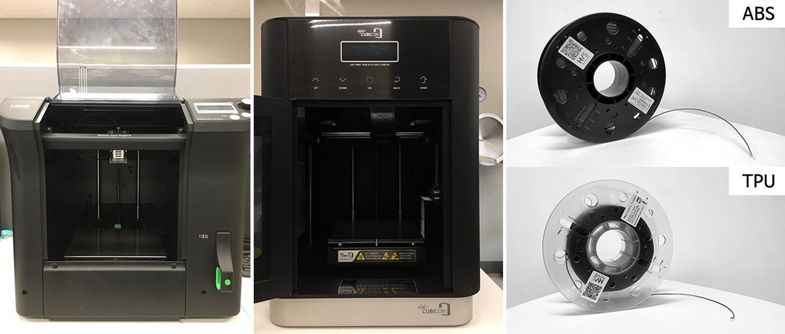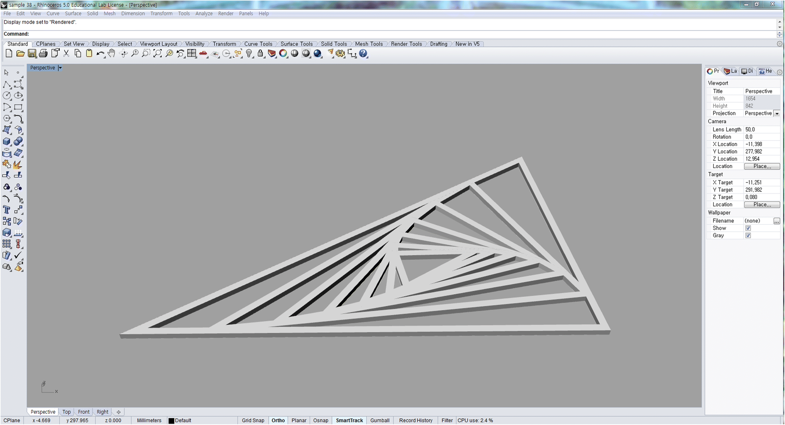Seoul National University: Researchers Use FDM 3D Printing to Explore Limitations in Creating Fashion
While 3D printing is certainly playing a noble role in numerous industries today—from the creation of medical devices that help babies survive to rocket engines nozzles built by NASA—most of us are fascinated by the strides made in fashion (a girl has gotta have a nice dress to wear to the party after all!), and enjoy the contagious enthusiasm of designers of all ages and experience levels exploring new technology to make bold statements. Student designs and haute couture aside though, is 3D printing actually doing the fashion industry any good?
 Sohyun Kim, Hyunjin Seong, Yusun Her, and Jaehoon Chun, all hailing from the Department of Textiles, Merchandising and Fashion Design at Seoul National University in Seoul, South Korea, explored the progress of fashion in ‘A study of the development and improvement of fashion products using a FDM type 3D printer.’ While acknowledging the role of 3D printing in fashion, the research team asserts that progress has been slow in comparison to other industries, and they set out to find solutions for this disparity, including fabricating clothes themselves to determine the best ‘complementary measures’ to use.
Sohyun Kim, Hyunjin Seong, Yusun Her, and Jaehoon Chun, all hailing from the Department of Textiles, Merchandising and Fashion Design at Seoul National University in Seoul, South Korea, explored the progress of fashion in ‘A study of the development and improvement of fashion products using a FDM type 3D printer.’ While acknowledging the role of 3D printing in fashion, the research team asserts that progress has been slow in comparison to other industries, and they set out to find solutions for this disparity, including fabricating clothes themselves to determine the best ‘complementary measures’ to use.
For this project, the team used an FDM printer to make three different sets of clothing using either TPU or ABS. In evaluating their creations and continuing to explore ways to improve, they considered:
- Materials limitations
- 3D modeling programs
- 3D printing issues
- Manufacturing processes
- Wearing processes
“Based on this research, it is expected that more diverse and active attempts to utilize 3D technology will be pursued by those who develop various fashion products,” explained the authors in their abstract.
Citing limitations in materials as a key factor in the slower progress of fashion in 3D printing, the authors state that more research has been performed so far in regard to accessories like jewelry instead of actual clothing. Along with that, FDM printers have mainly only been used to create fashion partially affected by 3D printing, or with attached accessories:
“Thus, in this study, three full-size clothing are manufactured using a FDM type 3D printer, with the aim of analyzing the limitations of the process and suggesting ways to mitigate them,” state the authors.
The team designed several pieces to be completely 3D printed, working from a geometrical motif. For modeling, they relied on Rhinoceros 5.0 and Grasshopper, with Cubicreator 2.5 R3 as a conversion program. Two entry-level FDM 3D printers were used: The Cubicon Single and the Cubicon Style. The researchers also experimented with ABS and TPU filaments.
The three different designs used were that of rectangles for the first, triangles for the second, and circles for the third.
In creating the first design, the team explored whether it was possible to 3D print quality clothing without the use of sewing. Inspired by the work of minimalist artist, Donald Judd, they chose repetitive rectangles as a design, and then the same patterns over and over to produce the desired shape.
“Rhinoceros was used as a modeling program for Design 1. Design 1 was based on the shape of the cross that is formed with two rectangles, 41 * 7 mm in size (W * D), and the height was designed to be 3 mm to give a three-dimensional effect,” stated the researchers. “The cross patterns that form the base are connected through hinges with 5 mm spaces between them. The hinges were modeled to be detachable, with a hole on a fixed plane through which a cylinder fits inside.”
TPU was used in this design, and the print job (using the Cubicon Single) took two hours and 33 minutes.
“Design 2 was modeled using Rhinoceros and Grasshopper and printed using the Cubicon Single printer, after which the printed parts were connected. Design 2 was created with the intention of exploring the manufacturing process when printing more complex forms of patterns and designs using Grasshopper. TPU filament was used to create a more fitting form of clothing on the human body.”
The design was inspired by nature: the spider’s web. The team made an impressive design ‘created by disassembling and reforming triangles.’ Innerwear was required due to the revealing nature of the design, and according to the designers they were inspired for that portion of the piece as they imagined petals trapped in the web.
The dress required 492 basic triangles and 34 six-layered triangles, with the first set taking three minutes to print, and the layered ones requiring around 24 minutes.
The third design was created with Rhinoceros and Grasshopper to model the base unit pattern, and then the 3D printed pieces were connected manually. The inspiration was that of a medieval knight helmet with ‘circular chain structure.’ Embracing the military style, the team chose ABS as the material of choice due to its ‘powerful physical property.’ They also chose a knit structure for the dress to embrace the natural curves of the wearer.
“This design was developed to ascertain if it would be possible to make clothing with only 3D printed materials,” stated the research team.
The Cubicon Style 3D printer was used to create the circular structures, with a total printing time of five hours and five minutes. The units were assembled manually, connecting the 3D printed rings.
Upon analyzing their work, the research team conceded that printing with the chosen materials on an FDM 3D printer was challenging. They found a variety of different challenges with both ABS and TPU, from issues with too much post-processing required (ABS) to difficulty in removing supports after 3D printing (TPU). There were also issues with clogging, sticking in use with TPU and problems regarding breakage with ABS.
They also found that FDM 3D printing led to increases in the amount of output due to size limitations, along with longer output times.
“Printing a single unit of a basic pattern takes a minimum of 30 min and printing an entire piece of clothing requires multiple printout processes, consuming much time and effort. Therefore, in this study, we tried to simplify the design and the pattern, and to model them without support as much as possible to minimize errors and time,” stated the researchers.
Their findings showed that indeed, improvement in materials is necessary. They also suggested that 3D printers should be more streamlined and efficient in preventing clogging and sticking. Along with that, they suggest better modeling programs. The team suggested that those creating fashion via 3D printing should experiment with a variety of different manufacturing processes. Post processing was definitely a ‘sticky’ point with the team too, as they recommend more study of post-treatment steps.
“During the process of this study, due to limitations on printing methods and materials, the difficulty in making wearable clothing with only 3D printout was revealed. Thus, fabric was used together for the production of clothing to supplement such limitations,” concluded the researchers. “However, if the development of material and printing methods and the subsequent studies on various motifs and connection methods continue, the introduction of the 3D printing method to the fashion industry will be accelerated. This will have an innovative impact on efficiency.”
“In addition, if a wearing test frame, including elements such as ease of operation and foreign body sensation, is provided, it is expected to help the 3D printed clothing into practical use. We hope that the utilization of 3D printing technology will increase in the field of fashion and that many follow-up studies will be conducted based on the findings of this study.”
What do you think of this news? Let us know your thoughts! Join the discussion of this and other 3D printing topics at 3DPrintBoard.com.
[Source / Images: A study of the development and improvement of fashion products using a FDM type 3D printer]Subscribe to Our Email Newsletter
Stay up-to-date on all the latest news from the 3D printing industry and receive information and offers from third party vendors.
Print Services
Upload your 3D Models and get them printed quickly and efficiently.
You May Also Like
Heating Up: 3D Systems’ Scott Green Discusses 3D Printing’s Potential in the Data Center Industry
The relentless rise of NVIDIA, the steadily increasing pledges of major private and public investments in national infrastructure projects around the world, and the general cultural obsession with AI have...
3DPOD 260: John Hart on VulcanForms, MIT, Desktop Metal and More
John Hart is a Professor at MIT; he´s also the director of the Laboratory for Manufacturing and Productivity as well as the director of the Center for Advanced Production Technologies....
Etsy Design Rule Change Reduces Selection of 3D Printed Goods
Online marketplace Etsy has implemented a rule change requiring all 3D printed goods on the site to be original designs. The update to the site’s Creativity Standards states, ¨Items produced using...
E-Beam OEM Wayland Additive Partners with USC Racing to 3D Print Titanium Exhaust Collector
Every year, standards organization SAE International holds a competition called Formula SAE, in which students from both undergraduate and graduate programs design, build, and race small formula-style race cars. For...










































